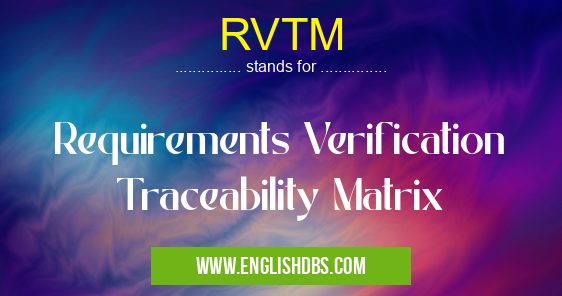What does RVTM mean in SOFTWARE
Requirements Verification Traceability Matrix or RVTM is an important tool used in the software development life cycle (SDLC) to verify that an application has all the right requirements, and that these requirements are being satisfied by the product being developed. The RVTM helps ensure a successful development process and final product.

RVTM meaning in Software in Computing
RVTM mostly used in an acronym Software in Category Computing that means Requirements Verification Traceability Matrix
Shorthand: RVTM,
Full Form: Requirements Verification Traceability Matrix
For more information of "Requirements Verification Traceability Matrix", see the section below.
Essential Questions and Answers on Requirements Verification Traceability Matrix in "COMPUTING»SOFTWARE"
What is an RVTM?
An RVTM is a Requirements Verification Traceability Matrix which is used in the software development life cycle (SDLC) to ensure that the software's requirements are being addressed and met.
What does an RVTM do?
An RVTM allows developers to track and trace each requirement from start to finish of the SDLC. This allows for verification of a requirement and also enables developers to monitor how well it was implemented in the finished product.
How does one create an RVTM?
An RVTM can be created using tools such as spreadsheets, database applications, or document management systems. The matrix should include each requirement along with its status, version number, verification steps taken, etc. The matrix should also include any necessary tests or performance evaluations made during each stage of development.
What components should be included in an RVTM?
Components that should be included in an RVTM include each requirement along with its status, version number, validation steps taken, description of tests/performance evaluations made, who verified it at every stage of development and if successful completion was achieved. Additionally, if any changes have been made throughout the SDLC must also be tracked within the matrix to properly assess any impacts they may have had on the given requirement.
What benefits does having an RVTM provide?
Having an accurate and up-to-date Requirements Verification Traceability Matrix provides several benefits throughout the software development life cycle such as improved visibility into progress being made on meeting requirements as well as stronger accountability for those involved in verifying requirements were met successfully at different stages of development. Additionally, it will reduce time spent troubleshooting problems found downstream since all associated testing data will already be available within one centralized location allowing for quicker resolution times.
Final Words:
As demonstrated above, having a well-created Requirements Verification Traceability Matrix provides many benefits including improving visibility into progress being made on addressing application requirements as well as providing more accountability for those responsible for verifying completed requirements at various stages throughout development. These qualities make creating a valid and up-to-date matrix essential regardless of project size or complexity ensuring a successful outcome when launching a new application or making changes to existing ones.
